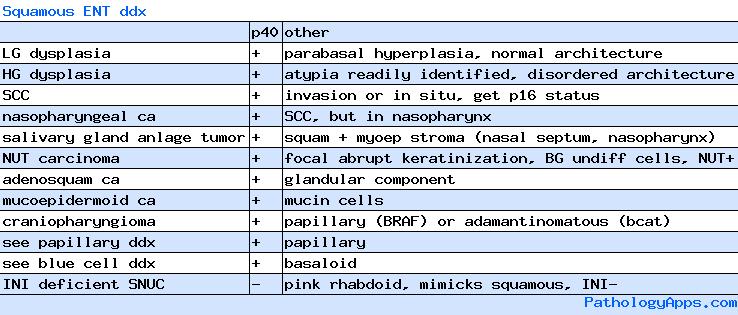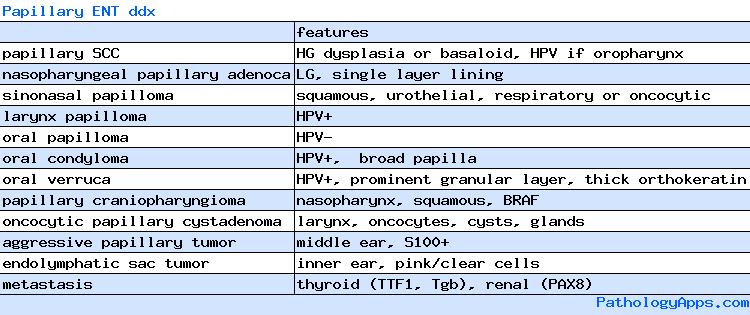larynx





Expand All | Collapse All
normal
- mucosa
- supraglottic and glottic: squamous, occasional patches of respiratory inferiorly
- false cord: squamous or respiratory
- true cord: squamous
- subglottic: respiratory
- hypopharynx: squamous
- trachea: respiratory
- stroma
- seromucinous glands (except true cords)
- true cords have loose connective and elastic tissue
- cartilage
- hyaline cartilage
- epiglottis is elastic cartilage with fenestrations
- age related changes
- mucosa entirely respiratory at birth
- oncocytic metaplasia of seromucinous glands at age > 50
- ossification of thyroid and cricoid cartilage in adults
Non-neoplastic
- cysts
- vocal cord polyp
- contact ulcer
- hyperplasia
- verrucous hyperplasia
- pseudoepitheliomatous hyperplasia
- keratosis
- hyperkeratosis
- parakeratosis
- dyskeratosis
- atypia
- koilocytosis
- radiation changes
- other
- necrotizing sialometaplasia
- amyloidosis
- metaplasia
WHO neoplasms
- malignant epithelial
- SCC
- verrucous carcinoma
- basaloid SCC
- papillary SCC
- spindle cell carcinoma
- acantholytic SCC
- adenosquamous carcinoma
- lymphoepithelial carcinoma
- giant cell carcinoma
- salivary gland type carcinoma
- mucoepidermoid carcinoma
- adenoid cystic carcinoma
- SCC
- neuroendocrine neoplasm
- carcinoid
- atypical carcinoid
- small cell carcinoma
- benign epithelial
- squamous papilloma
- papillomatosis
- salivary gland type adenoma
- pleomorphic adenoma
- oncocytic papillary cystadenoma
- soft tissue
- malignant
- fibrosarcoma
- MFH
- liposarcoma
- leiomyosarcoma
- rhabdomyosarcoma
- angiosarcoma
- Kaposi sarcoma
- MPNST
- synovial sarcoma
- borderline
- inflammatory myofibroblastic tumor
- benign
- schwannoma
- neurofibroma
- lipoma
- leiomyoma
- rhabdomyoma
- lobular capillary hemangioma
- lymphangioma
- granular cell tumor
- malignant
- bone and cartilage
- chondrosarcoma
- osteosarcoma
- chondroma
- giant cell tumor
- melanoma
- metastasis
TNM (useful for grossing)
- supraglottis
- subsites: epiglottis, arytenoid cartilage, false cord, aryepiglottic fold
- T1: one subsite of supraglottis, normal vocal cord mobility
- T2
- 2 or more subsites of supraglottis
- outside of supraglottis
- superior: tongue base, vallecula, medial pyriform sinus
- inferior: glottis
- T3: vocal cord fixation or invasion of...
- postcricoid area
- pre-epiglottic tissues
- paraglottic space
- minor thyroid cartilage erosion
- T4a: thyroid cartilage invasion or outside of larynx
- T4b: involves prevertebral space, mediastinum, or encases carotid artery
- glottis
- T1: vocal cord limited, normal mobility (may involve commissures)
- T1a: one cord
- T1b: both cords
- T2: involves supraglottis, subglottis, or impaired vocal cord mobility
- T3: vocal cord fixation or involves paraglottic space or minor thyroid cartilage erosion
- T4a: involves thyroid cartilage or outside of larynx
- T4b: involves prevertebral space, mediastinum, or encases carotid artery
- T1: vocal cord limited, normal mobility (may involve commissures)
- subglottis
- T1: subglottis limited
- T2: involves vocal cords +/- impaired mobility
- T3: vocal cord fixation
- T4a: invades through cricoid, thyroid cartilage, or outside of larynx
- T4b: invades prevertebral space, mediastinum, or encases carotid artery
- hypopharynx
- T1: one subsite of hypopharynx, <= 2cm
- T2: multiple subsites, adjacent sites, or 2-4cm
- T3: > 4cm or hemilarynx fixation
- T4a: involves thyroid/cricoid cartilage, hyoid bone, thyroid gland, esophagus, central compartment soft tissue (includes prelaryngeal strap muscles and subcutaneous fat)
- T4b: involves prevertebral fascia, mediastinum or encases carotid artery
- outside of larynx means:
- trachea
- neck soft tissue, deep/extrinsic tongue muscles
- genioglossus
- hyoglossus
- palatoglossus
- styloglossus
- strap muscles
- thyroid
- esophagus
N
- N1: single ipsilateral node, <= 3cm
- N2a: single ipsilateral node, 3-6cm
- N2b: multiple ipsilateral nodes, <= 6cm
- N2c: contralateral or bilateral nodes, <= 6cm
- N3: > 6cm
- midline considered ipsilateral
Staging
- 0: Tis
- I: T1
- II: T2
- III: T3 or N1
- IVA: T4a or N2
- IVB: T4b or N3
- IVC: M1
